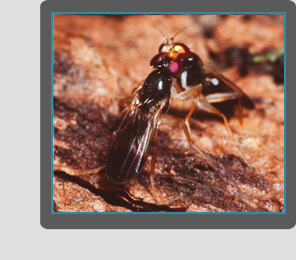| |

 Characteristics Characteristics
Species of the genus Craspedochaeta Czerny (treated as "Czernyola" prior to 1971) are the only acalyptrate flies with 4-5 fronto-orbital bristles of which the third bristle from the back is inclinate (the remainder are reclinate). Other characteristics of Craspedochaeta include: two pairs of dorsocentral bristles (a small third dorsocentral is rarely present); mid and hind tibiae with dorsal preapical tibial bristles; arista pubescent to short plumose; ejaculatory apodeme wide and flared at one end, appearing mushroom-shaped; hypandrial arm only weakly attached to the remainder of the hypandrium; phallus usually large and sac-like (some species have the phallus reduced to absent or with elongate sclerotized sections). Furthermore, as in most other Clusiodinae, the spermathecae are longitudinally segmented and the hypandrial complex exhibits extensive reduction and fusion of its components. Most Old World species and a couple of New World species exhibit pronounced sexual dimorphism in size and colouration.
Distribution
This genus is most diverse in the Oriental and Neotropical Regions, but species also occur in the Australian, Afrotropical and (occasionally) Nearctic Regions (Lonsdale & Marshall, 2006b; McAlpine, 1960; Sasakawa, 1971). The Nearctic records represent the northernmost occurrences of otherwise predominantly tropical species.
Relationships
Excluding the basal Allometopon Kertesz and Electroclusiodes Hennig, Craspedochaeta is the sister group to the remaining clusiodine genera, which have spermathecae that are pigmented and strongly telescoped (Lonsdale & Marshall, 2006a). McAlpine (1960) divided Craspedochaeta into the C. transversa, C. concinna (formerly C. atra), and C. biseta species groups. McAlpine (1960) revised the Australian Craspedochaeta and Sasakawa (1971) revised those species in the Oriental and Pacific Regions. Lonsdale & Marshall (2006b) revised the New World species, providing a species-level phylogenetic analysis.
Species groups
Three species groups are currently recognized within the predominantly pantropical genus Craspedochaeta: the C. concinna (formerly C. atra), C. transversa and C. biseta groups (Lonsdale & Marshall, 2006b). The C. concinna and C. transversa groups are found exclusively in the New World, and representatives of both extend into North America, but the biseta group (likely an artificial grouping) dominates the Old World and has only one Neotropical species (recorded from Bolivia and Ecuador). The C. transversa species group is the most easily recognized, having an additional pair of reclinate fronto-orbital bristles at the anterior margin of the frons, characteristic spermathecae and pregonites, and a subterminal flagellum on the female ventral receptacle. Most species also have lighter bristles, paler notal colouration, united cerci that are often large and plate-like, an elongate basiphallus, and an atrophied distiphallus and ejaculatory apodeme (Lonsdale & Marshall, 2006b).
Conversely, the C. concinna group is poorly defined, characterized by an absence of the prescutellar acrostichal bristles (independently developed in several species elsewhere in the genus) and atrophy of the subterminal flagellum of the female ventral receptacle (Lonsdale & Marshall, 2008b).
Species of the C. biseta group have two long pairs of dorsocentral bristles (reduction of the anterior pair is diagnostic of the other two groups) and a majority of species have the posterior fronto-orbital reduced or absent and the posterior genal bristle enlarged.
Biology
Very little is known about the biology and behaviour of Craspedochaeta, although males and females have been found to frequent downed branches or bare logs throughout the neotropics, particularly when dung baits are placed on the wood. Furthermore, as has been observed in species of other clusiodine genera such as Clusiodes, Hendelia (Marshall, 2000; Roháček, 1995) and Heteromeringia (Lonsdale & Marshall, 2007a), males of one Craspedochaeta species have been observed while engaging in agonistic behaviour at supposed lek sites. Several specimens of the Bolivian C. pullipleura Lonsdale & Marshall were observed on a small fallen branch, where if one male invaded the territory of another, the resident responded to the challenge by facing the invader and (usually) initiating a head-pushing competition.
North American species:
- Craspedochaeta annulipes
- Craspedochaeta concinna
- Craspedochaeta weemsi
|
|
 |